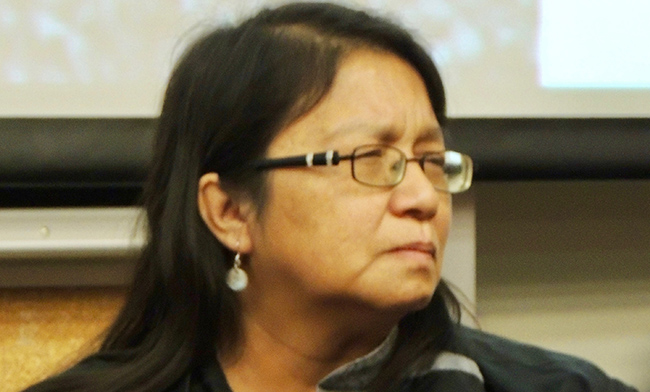Grassy Narrows still waiting for clean up

By Christine Miskonoodinkwe-Smith
TORONTO – Judy Da Silva, Lee Maracle and Vanessa Gray spoke to a packed room with the theme Mercury Justice Now on Nov. 6.
Earlier this year after decades of protesting by Grassy Narrows activists, the Ontario government set aside $85 million dollars to clean up the English Wabigoon river system. The river system was contaminated with nine tons of mercury back in the 1960s by a pulp and paper mill. However, with this $85 million that has been set aside, Ontario Premier Kathleen Wynne is still delaying the clean up of the river, and little continues to be done for the people of Grassy Narrows who have experienced decades of mercury poisoning.
Grassy Narrows needs further help in obtaining a “mercury home”, where those affected by mercury poisoning can still live close to home while they get care, receive fair compensation and better healthcare.
“I am very honoured that everyone came out to this event,” said guest speaker Judy Da Silva, citizen of Grassy Narrows. “It is getting harder and harder for me to walk but I came from Grassy Narrows to update you all on what is happening. We have been having meetings, and have done a lot of work. We have a new lawyer who understands us. Our number one priority is to get the river cleaned up. I want to say that you amplify us. You amplify our voice by supporting us.”
Da Silva also mentioned the sacrifice of the families.
“Often when you work on the frontlines, we sacrifice our time away from families to fight for those who don’t have a voice. I’m going to cry because It is not easy to see our relatives dying, and see all these things they are fighting for. We are in meetings and there are people on reserve who are ill and are still struggling. I want to make the people who poisoned our rivers accountable. We want to be alive, we want to be healthy, enjoy our children, our grandchildren but these poisons in our water, our air and in our animals, are preventing this. I may not see in my lifetime the changes we are fighting for but I hope my grandchildren will see it. I’ll keep doing this — fighting for Grassy Narrows until I die.”
Similar environmental injustices are happening in other First Nations. Just ask 25 year-old Vanessa Gray from Aamjiwnaang First Nation, also known as Chemical Valley. Gray, who is an environmental activist, spoke briefly about the Petrol Chemical industry and how it is not only impacting her community, but impacting First Nations people in general.
“Traditionally, as Anishinaabe people, we are not on just one reserve. We are spread out everywhere,” said Gray. “We have lived and worked on the land long before the chemical companies showed up. Sarnia and the Chemical Valley are not on its own, we are connected to Toronto, the tar sands, the pipelines and this impacts all the communities in between. The petro chemical industry is impacting us all because there are so many different methods that they use. We are seeing generational impacts, and genetic impacts because it is coming out in our bodies. Chemicals are being stored in our bodies and it is coming out in different ways. Basically, we are being exposed to everything that they are putting out into the environment and being used as guinea pigs. I want to try and connect my community to yours because we are not alone-we are all connected.”
Gray also said, “the justice system just doesn’t work out for Indigenous people when it comes to Indigenous rights, environmental rights- direct action is the better way to go and a way that we can move forward in a [decolonized] way.”
Five women from Guatemala were also in attendance. They are to appear in court against a Canadian mining company that has allegedly committed human rights atrocities against them and other environmental justice workers from their country


